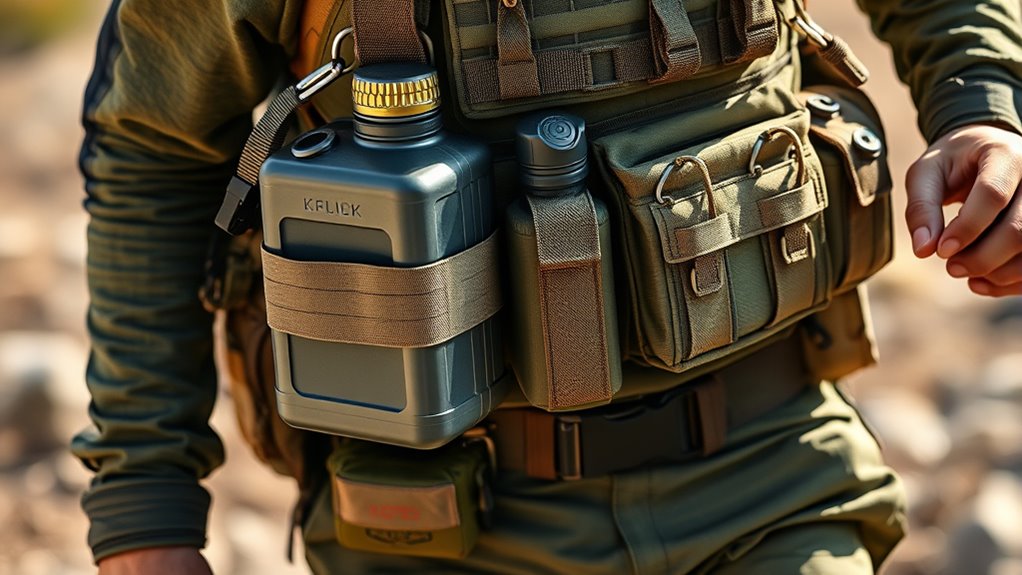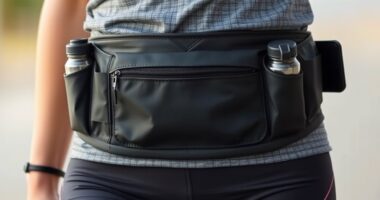When carrying fuel on the run, use specially designed vests or belts with secure, leak-proof compartments made from durable, chemical-resistant materials. Avoid makeshift solutions like pockets or improvised containers, as they pose spills and vapor hazards. Make certain containers are snug, sealed, and properly stored in reinforced compartments to prevent leaks and accidents. Upgrading your gear to the right equipment minimizes risks and boosts safety. If you want to learn more about safe fuel transport, keep exploring these essential tips.
Key Takeaways
- Use specially designed fuel vests or pockets with reinforced, leak-proof compartments for safe transport.
- Ensure containers are secure, snug, and properly sealed within the carriers to prevent leaks.
- Avoid carrying fuel directly in pockets; always use dedicated, padded holders or vests.
- Regularly inspect carriers and containers for damage, replacing any compromised equipment immediately.
- Keep fuel carriers away from heat sources, sparks, and enclosed spaces to minimize vapor hazards.

Have you ever wondered how to safely carry fuel while on the move? It’s a common concern for outdoor enthusiasts, hobbyists, or anyone who needs quick access to fuel without stopping. The key lies in choosing the right method—such as portable containers—and following strict safety precautions. Portable containers are specifically designed to transport fuel securely, but not all are created equal. Look for high-quality, approved containers made from durable, chemical-resistant materials. These containers often feature spill-proof caps, reinforced construction, and secure sealing mechanisms to prevent leaks. When selecting a portable container, avoid makeshift solutions like plastic bottles or improvised jugs, which can be prone to failure or accidental spills.
Once you have the right portable container, safety precautions become your top priority. Always store fuel in a well-ventilated area away from heat sources, open flames, or electrical sparks. When handling fuel, wear protective gear such as gloves and safety glasses to prevent skin contact or eye irritation in case of accidental splashes. Keep the container upright during transport, and avoid overfilling—leaving some space for expansion helps prevent pressure buildup that could cause leaks. It’s also wise to secure the container firmly in your vehicle to avoid movement or tipping during transit. Proper storage practices are essential to minimize hazards and ensure safe transport of fuel.
Carrying fuel in a vehicle or on your person requires additional attention. If you’re using a belt, vest, or pockets to carry smaller amounts of fuel, ensure these items are specifically designed for such purposes. Fuel pockets or specialized vests often have reinforced compartments with leak-proof linings, which reduce the risk of spills and contain fumes. When using these alternatives, double-check that closures are secure and that the container fits snugly. Avoid carrying fuel in your pockets directly—this is unsafe and can lead to accidental leaks or contact with your skin. Instead, use dedicated holders that are padded and sealed, providing both safety and convenience.
Always remember that fuel vapors are highly flammable and potentially hazardous. Never carry fuel in enclosed spaces like car trunks without proper ventilation. Be vigilant about keeping your containers away from heat sources, sparks, or open flames. Regularly inspect your portable containers for any signs of damage, cracks, or leaks, and replace them immediately if needed. By choosing the right containers and adhering to safety precautions, you can carry fuel efficiently and minimize risks on the go. Your safety, and that of those around you, depends on careful handling and smart storage practices.
Frequently Asked Questions
What Are the Safest Materials for Portable Fuel Containers?
You should choose portable fuel containers made from high-quality, safety-standard compliant materials like high-density polyethylene or metal. These materials guarantee durability and resist cracking or punctures, reducing leaks. Always check that the containers meet safety standards such as DOT or EPA certification. Using sturdy materials minimizes risk during transport, making your fuel carrying safer. Prioritize containers with secure caps and proper venting to prevent spills and fumes.
How Do I Prevent Leaks During High-Impact Activities?
It’s no coincidence that the key to leak prevention during high-impact activities lies in choosing the right container and securing it properly. Use fuel containers with impact-safe design features like reinforced seals and sturdy closures. Tighten caps firmly, and consider adding protective padding or impact-resistant carriers. These steps help guarantee impact safety, preventing leaks when you’re moving vigorously, so you can focus on your activity without worrying about spills or fuel loss.
Are There Legal Restrictions on Carrying Fuel in Public?
You should be aware that legal restrictions and fuel regulations often limit carrying fuel in public spaces. Many areas prohibit transporting fuel without proper containers or permits due to safety concerns. Always check local laws before carrying fuel, as regulations vary by jurisdiction. Violating these rules can result in fines or legal action, so make certain you’re compliant to avoid trouble and prioritize safety when handling fuel outdoors.
What Are the Best Cleaning Methods for Fuel Carrying Gear?
To clean your fuel carrying gear effectively, focus on proper fuel container maintenance and cleaning techniques. Rinse the gear with warm water and a mild detergent, ensuring you remove any residual fuel. Use a brush for stubborn spots and avoid harsh chemicals that could damage the material. Rinse thoroughly and let it dry completely in a well-ventilated area. Regular cleaning keeps your gear safe and free from fuel residue buildup.
How Long Can Fuel Be Stored in Portable Containers Safely?
Imagine a sturdy fuel container sitting in your garage, ready for emergencies. You can safely store fuel in portable containers for about 3 to 6 months, depending on the container’s durability and storage conditions. Keep it in a cool, ventilated place, and check regularly for leaks or deterioration. Properly stored, your emergency fuel supply remains reliable, ensuring you’re prepared without risking safety or fuel quality over time.
Conclusion
Carrying fuel efficiently keeps you prepared and safe on the move. Did you know that over 60% of travelers prefer using specially designed belts and vests for quick access? By choosing the right gear, you not only stay organized but also reduce the risk of accidents. So, next time you’re on the go, remember that the right carrying method makes all the difference—making your journey smoother, safer, and more convenient.








